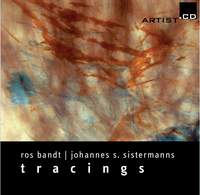: ros bandt, johannes s sistermanns

WERGO, 2012, ARTS 8120 2
http://www.wergo.de/
Australian composer and sound artist Ros Bandt and German electro-acoustic composer Johannes S Sistermanns’ CD Tracings is aptly named. It offers the sonic results of three key collaborations undertaken over the last 15 years, exploring the concept of tracing, both as noun—the evidence of an action or event— and also verb, the very act of mark-making itself.
Tracings opens with BYOS, a project devised by Sistermanns for ABC Radio in 2006 in which each artist brought their owns sounds to the studio to create a collaborative composition. The CD presents five short pieces segueing seamlessly, yet each with their own character. “BYOs Preludes: Take off” launches us into a cavernous space where industrial, grating noises play a supporting roll to the reverberance of the site itself (a signature technique of Bandt’s—see her 1981 release Improvisations in Acoustic Chamber). “BYOS Vivace: Gannetts” is energetic and vibrant as bird flaps, squawks and water sloshes are overlayed and effected to create escalating sheets of sound. “BYOS Adagio: Bells” uses slowed and muted bell tolls punctuated by pitch-shifted plosives and staccato vowels.
“BYOS Industrial Blues” in particular exemplifies the aspirations of musique concrète—each sound a discrete unit, reminiscent of actualities, yet the true source is unidentifiable—as mechanised shards of sound mingle with distant voices over an insistent hum. In contrast, “BYOS Epilogue: Catwalk” is peppered with tiny mewings, moans, creaks and footfalls and scrunches with more of a cinema foley feel. As a collection, the “BYOS” offers a fast moving, rich but never cluttered collection of sonic collages, presenting glimpses of territories that make you eager for more.
“Sonic Blue Red Tracings—Kami” gives the CD its name and the artwork imagery. In 2008 Bandt and Sistermanns were in residence in Wakayama in Japan, where they began to explore the sonic properties of paper. They also applied dye to their hair (Bandt auburn red, Sistermanns blue) and created paintings using their hair as brushes, exploring gestures such as swishing and whipping. These paintings form the basis of a graphic score, but also act as instruments in themselves as the paper is miked up, amplifying the performative actions. The recorded composition is underscored by distant tones (accordion perhaps) giving it an ethereal atmosphere, while the rustle of paper scrolls and the friction of hair rubbing and whipping create a textural landscape with small rhythmic eruptions. The result is a delicately industrial soundscape with some haunting sonorities that offer more elegance perhaps than the action painting of the live performance manifestation (accessible via available video documentation that can be found here and here).
The final two tracks on Tracings are from one of Bandt and Sistermanns’ earliest collaborations, “A Global Garden for Percy.” (“Whispering Between Stars” offered as a separate track is based on an excerpt from the larger work). As part of the 1997 Melbourne Festival program Ros Bandt was commissioned to create an installation, A Garden for Percy’s Delight, in the grounds of the Grainger Museum. For this she utilised recordings of some of the curious instruments Percy Grainger had created in pursuit of his idea of Free Music—music released from regular metric rhythm, exploring smooth pitch undulations, like ocean waves, that could in fact be performed by machines free of human intervention. Some of the instruments in the museum include the Kangaroo Pouch Machine which uses three oscillators to create sliding tones, the Knoxville Butterfly Piano and a Metallophone (Steel Marimba).
Bandt and Sistermanns also performed a live composition, “A Global Garden for Percy,” via an ISDN line linking Melbourne and Frankfurt, with the piece broadcast and recorded by the ABC’s The Listening Room. The result is a substantial 41-minute work with each composer’s contribution well melded. Given the paltry capacity for streaming even today, this live global linkup was and still is an impressive feat. (Bring on the NBN!)
“A Global Garden for Percy” is structured around recurring themes: watery field recordings made at Brighton Beach where Grainger grew up; samples of ascending and descending glissandi on his inventions; voices whispering his treatise; and deep plucked piano strings. At one point Grainger’s Viola d'Amore (adapted into an Alto Viol) is used to play a wistful version of John Dowland's 17th century song “Come Again,” alluding to Grainger’s love of folk music, only to be subsumed back into the composition's layering. At another point a helicopter, a sound of modern rupture, alerts us to the mechanical glissandi that surround us everyday. It’s a drifting dreamscape, using fascinating source material and taking dark and difficult turns—a fitting tribute to one of Australia’s most fascinating and complex composers.
Tracings as a whole is an engaging work with many textural and atmospheric pleasures. It rigorously explores not just the sonority of objects themselves, but the very nature of composition and collaboration.
Gail Priest
See also “Ros Bandt and Johannes S Sistermanns—15 years of collaboration” by Melinda Barrie, in the Australian Music Centre’s Resonate online journal.






